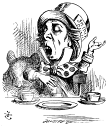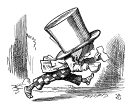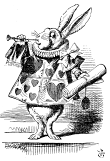Search us!
Search The Word Detective and our family of websites:
This is the easiest way to find a column on a particular word or phrase.
To search for a specific phrase, put it between quotation marks. (note: JavaScript must be turned on in your browser to view results.)
Ask a Question! Puzzled by Posh?
Confounded by Cattycorner?
Baffled by Balderdash?
Flummoxed by Flabbergast?
Perplexed by Pandemonium?
Nonplussed by... Nonplussed?
Annoyed by Alliteration?

Don't be shy!
Send in your question!
Columns from 1995 to 2006 are slowly being added to the above archives. For the moment, they can best be found by using the Search box at the top of this column.
 If you would like to be notified when each monthly update is posted here, sign up for our free email notification list.
If you would like to be notified when each monthly update is posted here, sign up for our free email notification list.
Trivia
All contents herein (except the illustrations, which are in the public domain) are Copyright © 1995-2020 Evan Morris & Kathy Wollard. Reproduction without written permission is prohibited, with the exception that teachers in public schools may duplicate and distribute the material here for classroom use.
Any typos found are yours to keep.
And remember, kids,
Semper Ubi Sub Ubi
|
His name is Paul Revere….
Dear Word Detective: Hello Word Detective, fellow Ohioan here. I see you are enjoying August here in the Buckeye state. Normally I can come up with a pretty fair folk etymology answer to almost any idiom, but “one horse town” has me stumped. It’s also the first time I didn’t find an answer already in your archives. I hope it piques your curiosity like it did mine. — Hoodya Love.
[Note: this column was sent to newspapers and subscribers last August.]
Ohioan? Moi? Um, OK, but my heart remains at 82nd and Broadway, in a booth at Cafe 82, the best Greek coffee shop in NYC. As for my tenure in the Buckeye State, I think James McMurtry said it best in his song “I’m Not From Here”: “I’m not from here, but people tell me / it’s not like it used to be / they say I should have been here / back about ten years / before it got ruined by folks like me.”
I am, however, sitting in the perfect venue in which to tackle your question. We don’t actually live in a town, but the one a few miles away (population 943) is currently embroiled in a fierce debate over whether to do away with the one traffic light in town. This is a town where people routinely drive their lawn tractors and golf carts to the gas station to buy beer, and some folks apparently find that light annoying.
A “one-horse town” is, of course, not simply a small town, but a very, very small town. The term is defined by the Oxford English Dictionary (OED) as “a small or rural town; a town where nothing important or exciting happens,” a definition many small-town residents would, of course, find objectionable.
Since “one-horse town” dates back to the mid-19th century, when most transport was still horse-drawn, one might suppose that “one-horse town” as a dismissive term for a small village might originally have implied that the town was so small that it had only one horse. (That actually wouldn’t make any sense; in a truly small town the horses would definitely outnumber the human residents, just as every single citizen of the town near us seems to own at least two cars.) But “one-horse” actually has a history quite apart from its application to small towns.
“One-horse” first appeared in print in the 1730s meaning “Of a vehicle or machine: pulled or worked by a single horse. Also, of a person: having or using only one horse” (OED). A “one-horse” carriage was a small rig, and a “one-horse” business was a humble operation (“‘One-horse farmers’ … had to struggle with the inconvenience of borrowing and lending horses,” 1887). By the mid-19th century the adjective “one-horse” had come to mean “small-scale” or “insignificant” in a general colloquial sense, and was applied to things that had no connection to actual horses, as it still often is (“Chest pains and breathlessness in a one-horse Greek airport, with the temperature nudging 105,” 2000). This is the sense of “one-horse” found in “one-horse town.” A “one-horse town” could have dozens of actual horses and still rate the name. “One-horse” even spawned the derivative term “one-horsey,” meaning “small and backward” (We liked the little-towness of Englewood. It was very one-horsey, but I loved it,” 1999).
Dead tree blues.
Dear Word Detective: In the paperback book titled: “Conversations with Anne Rice” by author Michael Riley, author Anne Rice speaks about a “cardboard dump” made to be placed in a retail store to call attention to a product, in this case her book. I went to the omphalos of dictionary searches, www.onelook.com. I did not get any help. So I looked to my list of computer network information source files and picked the computer file titled “The Word Detective.” Any information that you can come up with about the words “cardboard dump” will be greatly appreciated. — Skylar Donovan Malone.
Well, right off the bat you get ten points for using the word “omphalos,” which means literally “navel” in Greek, but also referred to a sacred conical stone in the temple of Apollo at Delphi that was supposed to mark the center of the earth. Today we use it to mean “hub” or “center.”
As for cardboard dumps, I know them well from my tenure in a regional chain bookstore many years ago in Columbus, Ohio. A precursor of Barnes & Noble, et al., the local franchise was owned by a husband and wife team of relentlessly unpleasant trolls. Our store, being across the street from Ohio State University, was considered the “literary” store in the chain. So imagine my surprise when the trolls decided one day that the first thing customers coming in to look for Shakespeare or James Joyce would see would be a enormous display, called a “dump,” made of garish pink cardboard, touting Marabel Morgan’s book “The Total Woman” (“It’s only when a woman surrenders her life to her husband, reveres and worships him and is willing to serve him, that she becomes really beautiful to him”). To say that this retrograde monstrosity did not go over well with our customers would be an understatement, and to fend off the torches and pitchforks we began eagerly passing out Mr. and Mrs. Troll’s phone number. The “dump” was gone within a few days, but the writing was on the wall and I decamped shortly thereafter.
So a “dump” in the bookstore sense is a self-supporting cardboard showcase displaying a particular featured book and usually festooned with smarmy advertising copy extolling the transformative power of said book. Dumps are usually found near the front of the store, and if they usually seem to be blocking your way, that’s on purpose.
There are actually four distinct “dumps” in English, the oldest of which, from the 16th century, meant a fit of absent-mindedness or depression. We still use this “dump” when we speak of being “down in the dumps.” Next, in the 18th century, came “dump” meaning a short, fat person or animal, still used in the adjectival form “dumpy.” About the same time yet another “dump” appeared, meaning a deep hole in the bed of a river or stream. The only thing all these “dumps” have in common is the fact that their origins remain mysteries.
The “dump” that is used to mean those cardboard displays appeared in English as a noun in the 19th century, but is based on the verb “to dump,” which dates back to Middle English and is of Norse origin. That verb means generally “to throw down, drop or discard,” and the noun, quite logically, originally simply meant a pile of stuff that had been “dumped,” including refuse (as in a “garbage dump”). In the early 20th century, around the time of World War I, “dump” took on the meaning of “a place where ammunition, provisions and equipment are stored for convenient access at a later date” (“The gunners may be called upon to fire at certain targets, such as cross-roads or houses used as infantry headquarters or ammunition and stores dumps,” 1919). That “collection of supplies” sense eventually gave us the cardboard merchandise “dump,” a temporary display designed to beguile consumers.
It’s not surprising, incidentally, that you hadn’t encountered this sense of “dump” before. It’s a bit of insider jargon used by publishers and booksellers but never to customers (to whom such contraptions are referred to as “displays”). Although “dump” has been used in this sense at least since the 1960s, the word is still commonly associated with its negative slang sense of “a run-down house, business or place,” and you don’t sell many books by conjuring up images of a hovel.
@ephemeral #meaninglessbabble
Dear Word Detective: I don’t know if I’m the last to notice this but the word “trending,” which used to modify other words, e.g., “the stock market is trending down,” “homeownership is trending down,” “property values are trending down” (boy, it’s hard to think of anything that’s trending UP these days), has become a stand-alone word. It seems to mean — approximately — “becoming more popular,” “an emerging trend,” or, on the web, “frequently linked to,” “Liked” in the Facebook sense, or “recommended.” So I’ll be told that a particular shoe designer is “trending,” and I’m supposed to know what that means. I’m not an Edwin Newman curmudgeonly defender of the status quo. I understand that language is what people say, not what the rules say they should say, and language changes and evolves. But a part of me still objects when language changes in a direction that strikes the ear like a wrong note in a piano concerto. Sure, change, but why change in an ugly direction and for no apparent reason? Is there anything that the new sense of “trending” gives us that the old one, or any number of other words, didn’t? — Joseph DeMartino.
That’s a good question. Due to space constraints, I’ve had to lop off your second question, which had to do with an emerging (and depressing) mangling of the venerable word “aback,” but I’ll use that for another column. Hey, I just noticed that my spell-checker doesn’t recognize “Facebook.” I’m gonna leave it that way.
When “trend” first appeared as a verb in Old English (as “trendan”), derived from Germanic roots, it meant simply “to revolve or turn around; to turn or roll oneself about.” By the 16th century, “trend” was being used to mean “to travel around, to skirt something” (e.g., a coast), or “to travel in a specified direction or following a certain course,” as a river, mountain range or other natural feature might (“In its course to the north, the Gulf Stream gradually trends more and more to the eastward,” 1860). By the mid-19th century, based on this use, “trend” was being used figuratively to mean “To turn in some direction, to have a general tendency (as a discussion, events, etc.)” (Oxford English Dictionary (OED)). This is the standard, neutral sense of “trend” as a verb today. The noun “trend,” which arose from the verb, followed the same general course (trend?) in evolution, and now means “the general drift or direction of thought, culture, etc.” or a specific example of such, e.g., “Platinum sinks are the latest trend in high-end houses.”
I did a search of Google News back to 1800 for “trending,” and it seems to have first appeared in print around 1850 in the “traveling in a certain direction” figurative sense, always modified by “up,” “down,” etc. So stock prices might be “trending up” or “trending down,” but they were never just described as “trending.” The use of “trending” by itself to mean simply “increasing” in some sense (usually popularity) seems to have arisen in the 1980s (“‘I’ve said to lighten up on them [documentaries] because I think it [comedy] is trending now,’ Lemasters said,” 8/28/86), although the date is hard to pin down.
I’d guess (and it’s just a guess) that the assignment of a positive polarity (and unmodified “stand-alone” status) to “trending” has been due at least partly to the rise of the adjective “trendy” in the early 1960s. “Trendy,” defined by the OED as “Fashionable, up to date, following the latest trend” (“That was how it had always been and how it would go on in spite of trendy clergy trying to introduce so-called up-to-date forms of worship,” Barbara Pym, 1977), is always used to describe something popular (even if the speaker uses “trendy” in a dismissive sense). So “trending” in this new sense essentially means “in the process of becoming trendy” and thus carries, at least ostensibly, a positive sense. Trends which are not considered positive, such as a sharp rise in homelessness among the unemployed in the US, are still always described in news accounts using modifiers such as “up” and “increasing,” and no one (I hope) would be depraved enough to describe sleeping in one’s car as “trendy.”
Do we need this new sense of “trending”? Not really, but, given the popularity of “trendy” as an index of value in our consumer culture, it was probably inevitable.
|
Makes a great gift! Click cover for more.  
400+ pages of science questions answered and explained for kids -- and adults!
FROM ALTOIDS TO ZIMA, by Evan Morris
 
|


 can be found
can be found 




Recent Comments